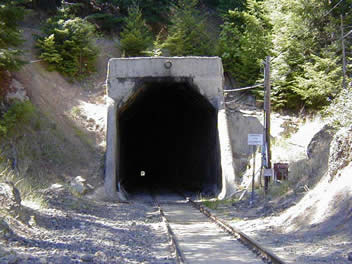13 was unlucky number for train passengers, robbers alike
D'Autremont brothers destroyed mail car, killed several people in bungled attempt at a heist in 1923, in American history's last Old West-style train robbery.
EDITOR'S NOTE: A revised, updated and expanded version of this story was published in 2017 and is recommended in preference to this older one. To read it, click here.

(Photo courtesy R. Wrede, www.tunnel13.com) At the south
end
of Tunnel 13, a small wreath can be seen commemorating
the
victims of the train robbery. This photo was taken before a
2003
fire severely damaged the tunnel; it was closed for 17
months for
repairs.
By Finn J.D. John — April 5, 2009
One of the most dramatic events in Oregon state history took place on Oct. 11, 1923, in a railroad tunnel in southern Oregon.
It almost sounds like a Hollywood movie script. The train was the “No. 13 Gold Special,” heading from Seattle to San Francisco. In command was engineer Sidney Bates – and it was to be his last run; he was ready to retire and start drawing a nice pension. And at the fateful hour, the train was just cresting the Siskiyou summit and testing its brakes, getting ready to go through Tunnel 13.
When the train slowed down to test the brakes, three men jumped aboard. These were the d’Autremont brothers: 23-year-old twins Ray and Roy and their teenage brother, Hugh. They’d been planning a train robbery for months, and they’d heard a rumor that $500,000 worth of gold was aboard, so Train 13 seemed like a good one to hit. They’d stolen some dynamite from a construction site and, of course, they were armed with pistols. These, they pointed at Bates and ordered him to stop.
Bates stopped the train at the end of Tunnel 13. Back in the train, the passengers were not pleased – coal smoke was starting to leak into the cars. Up front, the brothers weren’t happy either. The mail clerk, who was actually covering someone else’s shift, barricaded himself inside the car, so the brothers packed their dynamite around the car and touched it off.
Unfortunately for everyone, they had no idea what they were doing, and the amount of dynamite they used utterly destroyed the car and killed the clerk instantly.
Meanwhile, passengers and crew members were trying to fight their way through the smoke and fire to the south end of the tunnel, but it was too intense. Finally, a brakeman, Coyle Johnson, managed to fight his way through – and was promptly gunned down by the robbers.
Likely realizing time was running out and there was no sign of money or gold, the brothers decided to get away while they could. So, they killed engineer Bates and the fireman, Marvin Seng, the only witnesses who had seen them; then they dipped their feet in creosote to throw the bloodhounds off the scent and fled.
They might have gotten away with the crime, except for Edward O. Heinrich, a detective brought in to work on the crime. Heinrich, looking over a pair of overalls left by the bandits, deduced from pitch stains on the garments that the wearer was likely a lumberjack, and from the wear patterns on the buttons, that he was left-handed. But the most damning thing he found was a crumpled-up old mail receipt in one of the pockets. He was able to track this right back to the brothers.
Ten days after the crime, Ray felt enough time had passed that he might hop a freight train to Ashland to do some shopping. Once he got there, he opened a newspaper over a cup of coffee in a diner – and saw his name in a headline.
Of course, he raced right back to the hideout to tell the others the beans had been spilled. The brothers left the area, assumed new identities and started new lives – but four years later, the past caught up with them when Hugh, who had joined the Army, was fingerprinted.
All three drew life sentences. Hugh was paroled in 1959 and died a few months later; Roy, who’d been given a lobotomy in prison, also died just a few months after his parole in 1983. Ray, paroled in 1961, died in 1984, and spent many years working as a part-time janitor at the University of Oregon.
(Sources: Joers, Lawrence E.C. “The Siskiyou Train Robbery,” Great Moments in Oregon History. Portland: New Oregon Publishers, 1987 – a 6-page account by a physician who was aboard the train; https://ftp.wi.net/~maracon/lesson6.html; https://tunnel13.com; Sullivan, William L. Hiking Oregon’s History. Eugene: Navillus, 2006)














